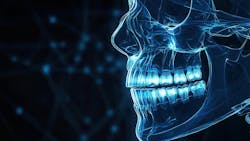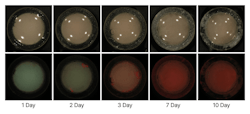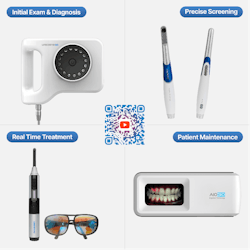Biofluorescence detection technology for better oral health
An article on the connection between biofilms and general health pointed out, “To maximize total health, a coordination in health care needs to be a symbiosis between the physician and dentist to eliminate the oral biofilm and aid in prevention of systemic disease or minimize those effects to improve the patient’s overall health and quality of life.”1 Before a dentist can eliminate oral biofilm, it needs to be detected, and for the best-case scenario, at the earliest possible time.
Detecting dental biofilm early with blue light technology
This is the basis of AIOBIO’s Biofluorescence Detection Technology. This device uses a safe and non-intrusive blue light to detect demineralization and biofilm. Under fluorescence, the biofilm glows red, allowing clinicians to evaluate and plan appropriate treatment as soon as possible. With BLISS technology, the plaque can be detected as early as three days after it starts to accumulate (figure 1).
Without biofluorescence, x-rays are the diagnostic imaging tool of choice. But, by the time an x-ray is able to detect biofilm, plaque, calculus, or caries, the tooth can already be damaged and need more aggressive or invasive treatment.
Radiation-free cavity detection for kids and teens
All ages can benefit from this technology. For pediatric patients, since BLISS does not emit ionizing radiation, parents would probably be open to more frequent checks of areas of concern. In children, caries progression can be quick and painful, so catching it early and educating parents and children on proper oral hygiene habits can prevent future complications. Also, orthodontic patients need to increase awareness of where biofilm is growing around their brackets to prevent possible damage to their teeth during treatment.
How biofluorescence helps protect dental implants
Adults can benefit in a variety of ways. Biofluorescence can show craze lines, cracks, or fractures that can lead to sensitivity, pain, or infection. Also, since implants are becoming increasingly popular, it is important to keep them in good condition. This device can detect the small lesions and subtle biofilm buildups that are associated with peri-implantitis. Inflammation and bone loss caused in part by biofilm on the implant’s surface can trigger inflammatory responses and speed up progression of oral disease, but by removing biofilm early from the implant’s surface, its longevity can be increased.
BLISS technology by AIOBIO is available for both office and home use. It features the LINKDENS QC, an extraoral camera for initial exams and diagnosis; the Qraypen C, a pen-like intraoral camera for capturing precise and detailed screening images; and the LINKDENS VU for convenient real-time oral screening and hospital use. There is even a device, the QScan Plus, which patients can easily and safely use at home to monitor oral health in all members of a family (figure 2).
With the greater connection between whole-body health and wellness, dentists can play an important part in prevention of oral issues rather than waiting for caries to hurt, implants to fail, or endodontic problems to arise. All without exposing patients to radiation. Patients will appreciate their clinician’s investment in early detection with biofluorescence technology.
Editor's note: This article originally appeared in DE Weekend, the newsletter that will elevate your Sunday mornings with practical and innovative practice management and clinical content from experts across the field. Subscribe here.
References
- Kurtzman GM, Horowitz RA, Johnson R, Prestiano RA, Klein BI. The systemic oral health connection: Biofilms. Medicine (Baltimore).2022;101(46):e30517. doi:10.1097/MD.0000000000030517
- Kim YS, Lee ES, Kwon HK, Kim BI. Monitoring the maturation process of a dental microcosm biofilm using the Quantitative Light-induced Fluorescence-Digital (QLF-D). J Dent.2014;42(6):691–696. doi:10.1016/j.jdent.2014.03.006
About the Author

Lou Shuman, DMD, CAGS
Lou Shuman, DMD, CAGS, is the CEO of Cellerant Consulting Group, dentistry’s leading corporate incubator and accelerator. He is a venturer-in-residence at Harvard’s i-Lab, cofounder of LightForce Orthodontics, a member of the Dental Economics advisory board, and founder of the Cellerant Best of Class Technology Awards. He was selected in 2021 by Global Summits Institute as one of the World’s Top 100 Doctors.
Updated September 20, 2022


